Posts Tagged ‘barra’
{{start}}
{{end}}
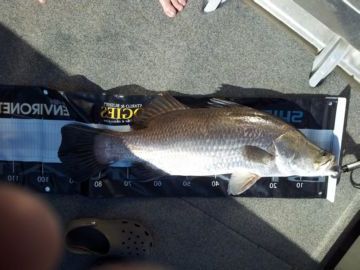
{{+1}}Fish on fly – Central Queensland{{-1}}
{{start}}
This post is a work in progress and lists the different species of fish I have landed on fly in Central Queensland. I have had a look through my photos from the last couple of years and added those that I have found but there are still some photo gaps which I'll add as I find the photos or will re-photo next time I catch the fish and add them at that stage. As I get time I will also add some text about each species and also some fly suggestions.{{end}}

{{+1}}Articulated booby{{-1}}
{{start}}
A great fly for barra and mangrove jack ... put a good cast into the target area and to allow the fly to settle for a few seconds before doing tiny twitches of the rod tip to cause some rings on the surface suggesting it's a natural struggling and then if that doesn't induce a strike to commence either a slow roly poly retrieve, or a series of stop start strips, back to the boat or bank. Whatever the retrieve the occasional pause followed by some twitches of the rod tip area good idea.{{end}}
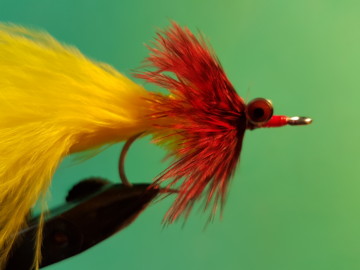
{{+1}}Gusto – sunburst variant{{-1}}
{{start}}
This is my variant of Peter Morse' Gusto fly and is one of my go to flies when targeting barramundi in Lake Awonga.
It's dressed on a #3/0 34007 stainless hook which is quite a heavy hook and that creates an effective "keel" effect. It has a long marabou tail and a dense hackle collar which creates plenty of currents around the fly that really get the marabou moving.
The overall length of the finished fly is around 10cm long.

| Hook | Eyes | Thread | Tail | Tail Flash | Body | Front hackle |
|---|---|---|---|---|---|---|
| Tiemco 34007 stainless in size #3/0 | Spirit River 'real eyes' 7/32" | My preference is white cotton | Yellow marabou blood plume | Sure Strike violet krystal flash - 6 strands | FNF jelly chenille in Picricish colour | One red saddle hackle and one grizzly hackle died deep red |
Process
| A |
|

|
|---|
| B |
|

|
|---|
| C |
Making the tail is a 3 step process |

|
|---|
| D |
|

|
|---|
| E |
|

|
|---|
| F |
|

|
|---|
| G |
|

|
|---|
| H |
|

|
|---|
| I |
|

|
|---|
| J |
This fly need a dense array of hackles that fill the remain free space on the hook shank so select hackles that have some fluffy barbules and a majority of hackle barbules that are about 1.5 times the gape of the hook. For this fly I have selected a red saddle hackle and a grizzly hackle that has been died red. Depending on the length of your hackles you may need up to 4 hackles. |

|
|---|
| K |
|

|
|---|
| L |
|

|
|---|
| M |
|

|
|---|
| N |
|

|
|---|
| O |
|

|
|---|
| P |
|

|
|---|
{{end}}

{{+1}}Chatto’s blue water minnow{{-1}}
{{start}}
This is a larger blue water version of my very successful 'Flats minnow". It's a very fishy looking fly and has a little blood spot that adds to the appearance of the fly being a wounded fish.{{end}}
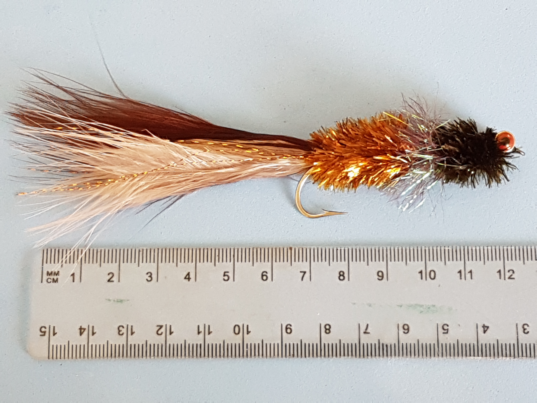
{{+1}}Articulated swimmer – “brown bomber” with optional rattle{{-1}}
{{start}}
Hard bodied Brown bomber lures are very popular as a lures for targeting barra and jacks in Queensland waters and most lure fishers have at least on in the lure tray. Based on the colours of the 'brown bomber' lure, particularly if I am targeting barra in fresh water dams like Awonga that are often a bit tannin stained, it's a fly I don't hesitate to tie on.{{end}}
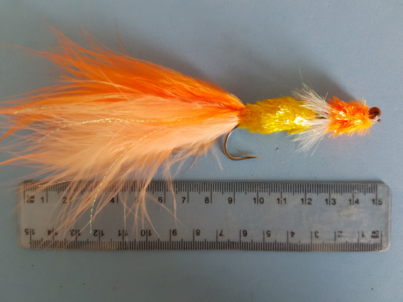
{{+1}}Articulated swimmer – mega – orange & yellow with rattle{{-1}}
{{start}}
This mega sized version of that original fly is my go to fly when I know I am targeting particularly big barra. It's tied on a size #3/0 Mustard 34007 hook and at 15cm long it's an uncomfortable fly to cast properly for long durations but I am happy to tie it on to target a specific fish or to fish that short period of the ebb tide when I am targeting big barra known to haunt bridge pylons and mid river structures that are only accessible for the short period of the ebb tide.{{end}}

{{+1}}Mud prawn – large 9cm or 10cm long{{-1}}
{{start}}
This is the biggest version of my Mud Prawn Fly and the one that I use when chasing barramundi in relatively clear salt water around structure such as drowned timber. It's a very durable fly that swims hook point up so that it's fairly snag resistant. It is designed not only to provide a representation of a prawn that is readily taken by barra of all sizes but it can be crept slowly over logs and other structure giving the maximum time for fish to respond, can be fished like a soft plastic or can be fished as a faster moving fleeing prawn.{{end}}
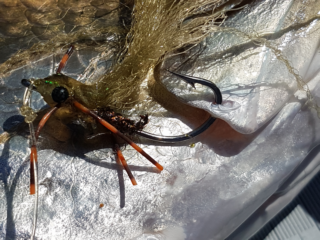
{{+1}}Spring comes early{{-1}}
{{start}}
Based on my diary what I call spring for the Boyne River in Central Queensland arrived about 20th August last year and the year before. This tear I reckon that it arrived a week earlier. The criteria I bases that on is a dramatic change in the weather patterns and the behaviour of budding fruit trees ... last week several local fruit trees were suddenly ablaze with their spring blooms. That followed just a couple of "Indian summer days" following a relatively cold snap. Now cold snaps in Central Queensland are mild at the best of times with overnight temperatures dropping down to around 8 degrees. This week the overnight temperatures are back up to around 15 degrees and the daytime temperatures up to 29 degrees.
Water temperatures have been on the climb as well and that has got the barra moving.
 |
 |
 |
Yesterday was a good start for the season with 3 barra landed of which two were between 60 and 70 cm plus a couple of other fish including a bream and a couple of small queenfish.
Water temperatures ranged fro 21.2 to 25.8 during the day with the fish most active around mid day when the water was a balmy 24 degrees.
Note the barra hooked jut off the edge of the gill plate!
{{end}}

{{+1}}Articulated slow roller{{-1}}
{{start}}
Tied in either Qantas or brown bomber colours this is a great fly when targeting barra in Lake Awoonga and other barra impoundments on those quiet days when the barramundi are sulking and you need a fly that is going to be in their face for a relatively long time but still active.{{end}}
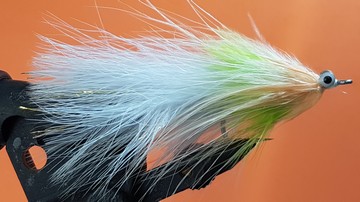
{{+1}}Chatto’s marabou bugger{{-1}}
{{start}}
My first fish on fly fell to the magic of a Woolly Bugger and many have gone the same way since then. Tied predominately as a prospecting fly for barra in Awoonga this fly also gets a swim in estuary and coastal waters when I am looking for grunter and fingermark.{{end}}













